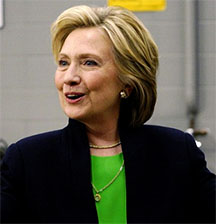By Bill Schneider
(Bill Schneider is professor of public and international affairs at George Mason University. Any opinions expressed here are the author’s own.)
(Reuters) Hillary Clinton’s video launching her campaign for the Democratic nomination was a montage of the New America. That’s the coalition Barack Obama brought to power in 2008: African-Americans, Latinos, Asian-Americans, working women, gays and lesbians, single mothers, Jewish voters, young people, educated professionals and the “unchurched” (the nearly one in five Americans who have no religious affiliation).

It’s the coalition that elected Obama twice, with a majority of the vote each time. That’s something even Bill Clinton couldn’t achieve. Many in these groups didn’t bother to vote when Obama was not on the ballot in the 2010 and 2014 midterms. Will they show up for Hillary? They will if Republicans keep insisting that a victory for Clinton would be “a third term for Obama.”
The New America is now the Democratic Party. To win, Clinton has to do more than Obama ever managed. She must do two things at the same time: hold the New America coalition together (as Obama did — twice) and build a broader governing coalition (as Obama did not really do). It won’t be easy.
No sooner had Clinton declared than Republicans started calling her a candidate of the past. “Just yesterday, a leader from yesterday began a campaign for president by promising to take us back to yesterday,” Senator Marco Rubio (R-Fla.) said when he announced his campaign for the Republican nomination on Monday.
If she wins, Clinton would become the first woman president of the United States. That doesn’t sound like the candidate of yesterday. It sounds like diversity and inclusion — the rallying cry of the New America.
If Republicans nominate former Florida Governor Jeb Bush, the “candidate of the past” argument would go away. The past under President Bill Clinton looks a whole lot better to voters than the past under President George W. Bush. The Monica Lewinsky episode was not the equivalent of war in Iraq. Asked last year which president of the past 25 years they admire most, 42 per cent of Americans named Clinton. Just 17 per cent said Bush.
According to Hillary Clinton’s pollster, what voters want in 2016 is a president who can “get things done.” That’s their biggest complaint about Obama. He can’t get immigration reform, he can’t get climate change legislation, he can’t roll back Islamic State, he can’t stop Russian President Vladimir Putin’s aggression in Ukraine, he can’t get along with Israel. And there’s no “Obama boom.”
There are two ways to get things done. One is to beat your opponents’ brains out. Obama is not much of a fighter. He’s more of a thinker and an inspirational figure. Hillary Clinton, on the other hand, is tough and relentless. “One thing you know about me is that I am no shrinking violet,” she said when she ran against Obama for the Democratic nomination in 2008. “If I tell you I will fight for you, that is exactly what I intend to do.”
Clinton ran far ahead of Obama among white working class voters in the 2008 Democratic primaries. “They think she’s tough,” an Obama strategist told Politico. Clinton never gave up in 2008. She stayed in the race until the very end. Her determination earned her more admiration than resentment.
The other way to get things done is to build consensus. That’s hard to do when the country is so bitterly divided. With the rise of the New America, the Old America has become a resistance movement. It won’t go down without a fight. Obama tries to make deals with Republicans, but they want nothing to do with him.
Bill Clinton actually did make a lot of deals with Republicans — on welfare reform, on free trade, on a balanced budget, on financial deregulation. That’s one reason so many voters admire him.
But not the left. They believe Clinton sold them out on those deals, and they’re afraid Hillary Clinton will do the same thing. That’s why they want a strong progressive to get into to the race and challenge her. They want someone who won’t make deals with the enemy. They’re not interested in the politics of “kumbaya.”
Can Hillary Clinton be a consensus-builder? It sounds far-fetched. She has a reputation as a highly polarizing figure, which she was before she became secretary of state. Now she’s back in politics, and Hillary-haters are springing into action. The Associated Press reports that at least 10 political organizations list “defeating Hillary Clinton” as their primary mission in their filings with the Federal Election Commission.
Nonetheless, it’s the kinder, gentler Hillary who seems to be running for president this time. She is not planning a “shock and awe” campaign like 2008. Her announcement video was so soft-focus it looked like an ad for air freshener. (It was the sort of ad that might run before a video. Watching it, you kept waiting for her video to start. Then suddenly you realized, “Oh. That’s the actual announcement.’’) In Silicon Valley in February, Clinton urged fellow Americans to “get out of our mind-sets, our partisan bunkers” and find “a nice warm purple space where we’re trying to solve problems.”
Her campaign is positioning her as more “relatable.” She’s a world-class celebrity who has spent years dealing with kings and presidents and diplomats. She’s going to spend the next nine months listening to farmers in Iowa and teachers in New Hampshire.
Can Clinton be a fighter and a consensus-builder at the same time? She hopes so. She talks about devising a plan and “bringing people to that plan, focusing on common-sense solutions and being relentless in driving toward them.”
A tough, relentless consensus-builder!
With her entry into the 2016 race, there is one thing you can safely predict: This campaign will be all about Hillary.









